THE ART OF LOSS AND PRESERVATION
By Coral Hull
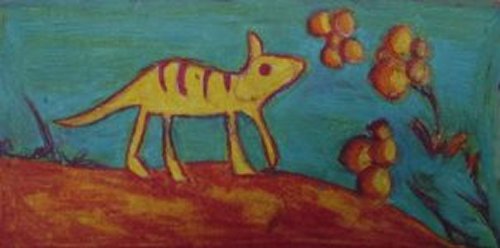
Thylacinus cynocephalus - "The pouched dog with the wolf's head".
Welcome to the seventh issue of Thylazine: The Australian Journal of Arts, Ethics & Literature.
Any notion of permanence is an illusion.
During the act of creation, I have at my most intense moments, avoided the self-consciousness of 'being a poet', 'being a writer', 'being an artist' and 'being a photographer' and have instead focused on just being.
Often this would mean no creation at all, or at least no conscious intention of creation until after the act had occurred. After the act of creation is when the process must become conscious or self-conscious if it is to adequately communicate to others or contribute to the greater culture. It is when an audience or the third party is taken into account and the editorial process begins, that consciousness in art is best utilised. That's if the art is to become public.
Much art does not become public. Much art is not recorded, awarded, preserved or represented in a similar way to how much history is not represented. Much of what we are is not permanent and nor can it be restricted to permanence. Preservation is about knowledge but it is not about truth. Much is lost. To quote J.R.R. Tolkien on the death of the she-elf Arwen Evenstar, "...she laid herself to rest upon Cerin Amroth, and there is her green grave, until the world is changed and all the days of her life are utterly forgotten by men that come after..."

|
What the art does may not become public, cultural or historical knowledge. It may not contribute to the narrow perception we have of human-centric culture and human-centric history. What the art does may remain unknowable, unnamable or unreachable. It may remain remote, secret and holy. |
[Above] Coral Hull and Judith Rodriguez, Deakin University, Victoria. (photographer unknown, 1995)
It may even remain beyond the words and thoughts of the artist and hence the perception and control of humanity. It may remain in the realms of the mystic and of that which cannot be adequately described, harnessed, altered, censored and utilised to suit the needs of some over the needs of others.
The loss of the permanence of art occurs within the oral traditions. The emphasis is off the preservation of material product and on the impact of the act of creation only as it exists in the present. There is an impact but the impact is not lasting. Does this matter? For aren't all acts of preservation merely attempts to control what is beyond our control? And isn't the act of promoting and maintaining a specific cultural or historical perspective simply humanity's age-old struggle for immortality, or for the power over life and death to be ultimately 'won' by the culturally elite? Hence all history, or the description and preservation of what we have come from, is based on material wealth and not spiritual truth.
Isn't this 'will to power' what all the fighting in the art world is about? And look what we have left at the end of the war. We have a wounded culture that poses as a victor and whose riches are based on the loss of the majority. What is presented to us as permanent or 'as art' is less than a fraction of the truth. When I was a student we studied The History of the Arts, a compulsory subject at the art institution. It was all about The Great Masters. There was no mention of 'the great mistresses', the women of the day, aside from the naked ones who had been observed, screwed, recreated, and recorded for the prosperity of the ruling class and for historical evidence of yet another culture that had waged war for the sake of permanence.
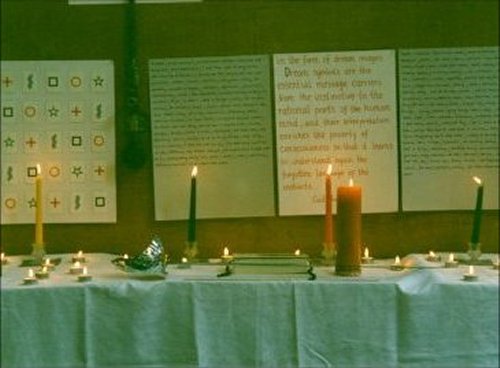
[Above] The final assessment, First Year, South Australian College of Advanced Education. (Photo by Coral Hull, 1990)
Like other students who attended Casula High in Sydney's western suburbs, I was told that I would come to no good and that I couldn't beat the system by teachers who sexually predated upon students with the unspoken and unwritten permission of the system. While at the University of Wollongong, I was set up to fail first year when several lecturers deliberately lost my papers, but found them again after I lodged a complaint. When I was a student at the SCAE (South Australian College of Advanced Education), I was banned from giving a tutorial on art and pornography because it was considered controversial. The reason given at the time was that several of the lecturers enjoyed pornography and believed the equation of sex equals violence to be acceptable.
Whatever my beliefs and the beliefs of those in charge, it soon became obvious that the process of control and censorship was in full-swing at all three insititutions of learning. However it was through the examination process of the art institution, that I really detected the attempt to control the creation of art by students and hence all future culture, or what would become history and hence immortal, at least until the next mass extinction upon the earth. Even on this most basic level the art-world-war was about what would remain and what would not remain. While the students learnt about 'what was art' and 'what was not art' and while often that question was left open, the students were also expected to conform to the rules of the art institution.
I also objected to the way that the staff had attempted to humiliate and control the student artists at the SCAE. From my perspective, it was time to not participate in THE LIE. Rather than have my artwork torn apart by the intellect of the lecturers, who had reduced many students to tears during the mid year round of 'examination' and 'judgment' and whom I no longer trusted to challenge my way of thinking, I simply acted as the Elves did in Tolkien's Middle Earth or perhaps in the way which Australia's indigenous population have acted.
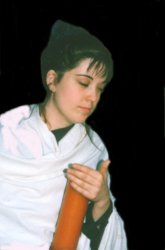
|
I retreated to the realms of the mystic and much to the horror and amusement of other students, my art retreated with me.
I hid my creation in order to protect it against the control of the ruling class - the societal and cultural elite who were busy working their own form of magic within the institution.
On my first year final 'assessment' at the SCAE I held a mock Wiccan/ Christian ceremony involving various 'cultural' icons and retracted my year of artwork into what the Wiccans would called several Books of Shadows.
I lit the candles, held a Bible and declared all art as mystical and beyond the reach of any institution created by humanity and even beyond the realm of human imagination. In a symbollic gesture and lead by a truth greater than fear, I left the South Australian College of Advanced Education with two other student 'followers' holding a candle and draped in a sheet. |
[Above] The Departure, First Year, South Australian College of Advanced Education. (photographer unknown, 1990)
I left my art behind and did not care whether I passed or failed the 1st year of the Bachelor of Conceptual Arts degree, for in the eyes of a greater power than ourselves our failure and success did not lie in the judgment of the institution on 'assessment day', or in the hands of humanity, but within the realms of the holy.
I knew that not only art, but truth was at stake if I submitted to the examination process. I believed in the teaching of the techniques of art and interaction amongst artists. I believed in being challenged and in personal and artistic transformation via learning. I met some interesting people from the middle classes. But I did not believe in the ultimate categorisation, judgment and allocation of marks for creative art. For these people were employed by the institution and came with the prejudice of the system that was put in place by the ruling class. Either they were employed to uphold the system or perhaps they fought 'the long defeat' quietly working to change the structure from within. I do not know. But why preach freedom within the prison when you can be it?
I was warned to go back and open my books to the examination. But I left and I never went back. As it turned out they passed me. Likewise, I was also passed at several other institutions. That was in 1990. I am now a Doctor of Creative Arts, whatever that means. But the day I walked out of the South Australian College of Advanced Education was the best thesis I ever produced. As for the Books of Shadows - they were never open to examination and hence they have not been preserved, but instead have passed into oblivion.
Therefore this came to be the day where the institution examined the unknowable and it passed the test. How could it not? These are a few of my thoughts recorded on 31st December in the year 2002. Because of the nature of Thylazine and all contained herein, I do not expect that it would be fully endorsed by any government or institution and nor do I expect that it would become part of the culture or history of the ruling class. But as long as we are here now and as long as our art is being shared by each other today, then that is what matters in the end. The future is not ours to create, control or predict. "All we have to decide is what to do with the time that is given us." (Gandalf the Grey, The Fellowship of the Ring, J.R.R. Tolkien.)
Dr. Coral Hull (Editor)
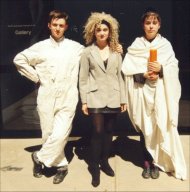
|
Thylazine thanks the following people for their generosity: MG Michael ($20.00), Dan O'Donnell ($25.00), Jan Owen ($20.00) and The Literature Board of The Australia Council for The Arts ($2,500.00) towards Thylazine No.7 and The Thylazine Foundation's charitable work.
A special thanks to the contributors; Richard James Allen, Melissa Ashley, Peter Goldsworthy, Alan Gould, Liz Hall-Downs, Philip Hammial, Wednesday Kennedy, Martin Langford, Myron Lysenko, Meg Mooney, Stephen Oliver, Geoff Page, Craig Powell, Kerry Reed-Gilbert, Martha Richardson, Brendan Ryan, Hazel Smith, Nicolette Stasko, Thom The World Poet and the many artists and photographers whose work is included in this issue. |
[Above] Outside the gallery, First Year, South Australian College of Advanced Education. (photographer unknown, 1990)
And others; Stephen Booth, C. Campbell from The Thylacine Museum, Iain Fraser, Patty Mark and the Action Animal Rescue Team, Jenni Mitchell, "Shamrock" and "Judy" the donkey and The Good Samaritan Donkey Sanctuary, Kindi and Binda who renew my dreams on a daily basis, and the eleven black angus cows from Rylstone: Molly, Emma, Caliban, Millie, Amanda, Monica, Stevie, Maggie, Ruby, Rachel and Faith. (r.i.p. Kinsella, 2001), and lastly to Josh, Marla and The Envirolink Network (Pennsylvannia, USA) without whose support and assistance this website would not be possible.
About the Writer Coral Hull
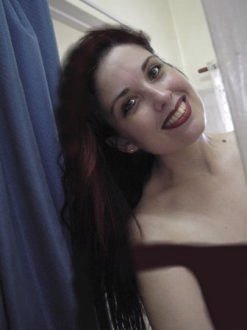
|
Coral Hull is the author of over thirty-five books of poetry, fiction and photography. She is an animal rights advocate who has spent much of her life working voluntarily on behalf of animals, both as an individual and for various non-profit organisations. She has recently completed a book called Voices from the Dark, exploring mental processes and creativity. Her book Broken Land: 5 Days in Bre won the Victorian Premiers Award in 1998 and was broadcast on ABC Radio National. She received her first literary grant (Established Writer category) from the Literature Board of The Australia Council for the Arts in 2001. Coral is the Editor and Publisher of Thylazine, an electronic journal featuring articles, interviews, photographs and the recent work of Australian writers and artists. She completed a Doctor of Creative Arts Degree (Creative Writing Major) at the University of Wollongong in 1998. When not on specific assignments in regards to her writing and photographic work, Coral lives in Sydney. An extensive biography, list of publications, awards, festivals, interviews, articles, reviews and photo and art folios can be found on Coral's website. |
[Above] Coral Hull, Elliot Hotel, Elliot, Northern Territory, Australia. (Photo by Coral Hull, 2001)
I Next I
Back I
Exit I
Thylazine No.7 (March, 2003) |



